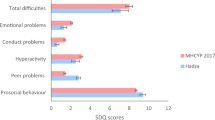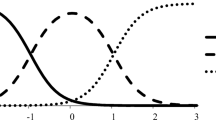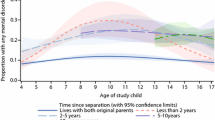Abstract
We present epidemiological data from a multi-centre study on psychiatric symptoms among 6017 8–9-year-old children representing a total annual birth cohort (N=60007) in Finland. The results are based on three questionnaires: the Rutter Parent Scale (RA2), the Rutter Teacher Scale (RB2), the Children’s Depression Inventory (CDI). The proportion of children that scored above the cutoff points, indicating probable psychiatric disturbance, were 11.2% for the RA2, 13.9% for the RB2 and 6.9% for the CDI. Twenty-four percent of the subjects scored above the cutoff point on at least one of the questionnaires. Low family social status and disrupted family relations correlated strongly with high rates of symptoms in the children.
Similar content being viewed by others
References
Achenbach TM, Howell CT (1993) Are American children’s problems getting worse? A 13-year comparison. Journal of the American Academy of Child and Adolescent Psychiatry 32: 1145–1154
Almqvist F, Ikäheimo K, Kumpulainen K, Tuompo-Johamsson E, Linna S-L, Puura K, Moilanen I, Räsänen E, Tamminen T, Piha J (1999) Design and subjects of a Finnish epidemiological study on psychiatric disorders in Childhood. European Child and Adolescent Psychiatry 8: Suppl. 1 (this issue)
Almqvist F, Puura K, Kumpulainen K, Tuompo-Johansson E, Henttonen I, Huikko E, Linna S-L, Ikäheimo, Aronen E, Katainen S, Piha J, K Moilanen I, Räsänen E, Tamminen T, (1999) Psychiatric disorders in 8–9 year-old children based on a diagnostic interview with the parents. European Child & Adolescent Psychiatry, Supplement (this issue)
Almqvist F, Tuompo-Johansson E, Panelius E, Aronen E, Kairemo A-C (1991) Screening for psychiatric symptoms on the basis of the Rutter Parents questionnaire. In: Tamminen T, Almqvist F, Piha J (Eds) Psychiatric Symptoms in Finnish Children. Reports of Psychiatria Fennica 91: 21–33
Almqvist F, Tuompo-Johansson E, Panelius E, Aronen E, Kairemo A-C (1991) Screening for psychiatric symptoms on the basis of the Rutter Teacher questionnaire. In: Tamminen T, Almqvist F, Piha J (Eds) Psychiatric Symptoms in Finnish Children. Reports of Psychiatria Fennica 91: 35–46
Anderson J, Williams S, McGee R, Silva P (1987) DSM-III disorders in preadolescent children. Archives of General Psychiatry 44: 69–76
Bird HR (1996) Epidemiology of childhood disorders in a cross-cultural context. Journal of Child Psychology and Psychiatry 37: 35–49
Bird HR, Gould MS, Yager T, Staghezza B, Canino G (1989) Risk factors for maladjustment in Puerto Rican children. Journal of the American Academy of Child and Adolescent Psychiatry 28: 847–850
Costello E, Angold A (1988) Scales to assess child and adolescent depression. Checklists, screens and nets. Journal of the American Academy of Child and Adolescent Psychiatry 27: 726–737
Costello EJ, Burns BJ, Angold A, Leaf PJ (1993) How can epidemiology improve mental health services for children and adolescents? Journal of the American Academy of Child and Adolescent Psychiatry 32: 1106–1113
Cox A, Rutter M (1985) Diagnostic appraisal and interviewing. In: Rutter M, Hersov L (Eds) Child and Adolescent Psychiatry. Modern Approaches (pp. 233–250), London: Blackwell Scientific Publications
Elander J, Rutter M (1996) An update on the status of the Rutter Parents’ and Teachers’ scales. Child Psychology & Psychiatry Review 1:31–35
Fombonne E (1994) The Chartres study: I. Prevalence of psychiatric disorders among French school-aged children. British Journal of Psychiatry 164:69–79
Fundudis T, Berney T, Kolvin I, Famuyiwa O, Barrett, L, Bathe S, Tyrer S (1991) Reliability and validity of two self-rating scales in the assessment of childhood depression. British Journal of Psychiatry 159:Suppl 11, 36–40
Graham P (1967) Perceiving disturbed children. Special Education 56:29–33
Hodges K (1990) Depression and anxiety in children: A comparison of self-report questionnaires to clinical interview. Psychological assessment. American Journal of Consulting and Clinical Psychology 2:376–381
Kaslow N, Rehm L, Siegel A (1984) Social-cognitive correlates of depression in children. Journal of Abnormal Child Psychology 12: 605–620
Kolvin I, Garside R, Nicol R, Leitch I, Macmillan A (1977) Screening schoolchildren for high risk of emotional and educational disorder. British Journal of Psychiatry 131: 192–206
Kovacs M (1981) Rating scales to assess depression in school-aged children. Acta Paedopsychiatrica 46: 305–315
Kovacs M (1985) The childrens depression inventory. Psychopharmacological Bulletin 21:995–998
Kovacs M (1992) Childrens Depression Inventory. CDI, Manual. Ontario: Multi-Health Systems Inc.
Kresanov K, Tuominen J, Piha J, Almqvist F (1998) Validity of child psychiatric screening methods. European Child and Adolescent Psychiatry 7:85–95
Kronenberg Y, Blumensohn R, Apter A (1988) A comparison of different diagnostic tools for childhood depression. Acta Psychiatrica Scandinavica 77:194–198
Larsson B, Melin L (1992) Prevalence and short-term stability of depressive symptoms in schoolchildren. Acta Psychiatrica Scandinavica 85:17–22
Matsuura M, Okubo Y, Kojima T, Takahashi R, Wang Y, Shen Y, Lee C (1993) A cross-national prevalence study of children with emotional and behavioural problems-a WHO collaborative study in the Western Pasific region. Journal of Child Psychology and Psychiatry 34:307–315
Morita H, Suzuki M, Kamoshita S (1990) Screening measures for detecting psychiatric disorders in Japanese secondary school children. Journal of Child Psychology and Psychiatry 31:603–617
Morita H, Suzuki M, Suzuki S, Kamoshita S (1993) Psychiatric disorders in Japanese secondary school children. Journal of Child Psychiatry and Psychology 34:317–332
Nelson W, Politano P, Finch A, Wendel N, Mayhall C (1987) Children’s depression inventory: Normative data and utility with emotionally disturbed children. Journal of the American Academy of Child and Adolescent Psychiatry 26:43–48
Offord DR, Boyle MH, Racine Y (1989) Ontario child health study. Correlates of disorder. Journal of the American Academy of Child and Adolescent Psychiatry 28:856–860
Papatheophilou R, Bada K, Micheloyiamiannakis I, Makaronis G, Pantelakis S (1981) Psychiatric disorders in 6- to 8-year old children in the greater Athens area. Bibliotheca Psychiatry 160:92–100
Rutter M (1967) A children’s behaviour questionnaire for completion by teachers: Preliminary findings. Journal of Child Psychology and Psychiatry 8:1–11
Rutter M, Graham P (1966) The reliability and validity of psychiatric assessment of the child: I. Interview with the child. British Journal of Psychiatry 114:563–579
Rutter M, Tizard J, Whitmore K (1970) (Eds) Education, Health and Behaviour. London: Longman
Rutter M, Cox A, Tupling C, Berger M, Yule W (1975) Attainment and adjustment in two geographical areas. I. The prevalence of psychiatric disorder. British Journal of Psychiatry 1326:493–509
Rutter M, Tizard J, Yule W, Graham P, Whitmore K (1976) Isle of Wight studies, 1964–1974. Psychological Medicine 6:313–332
Saylor C, Finch A, Baskin C, Saylor B, Darnell G, Furey W (1984) Children’s depression inventory: Investigation of procedures and correlates. Journal of the American Academy of Child Psychiatry 23:626–628
Saylor C, Finch A, Spirito A, Bennett B (1984) The childrens’s depression inventory: A systematic evaluation of psychometric properties. Journal of Consulting and Clinical Psychology 52:955–967
Schachar R, Rutter M, Smith A (1981) The characteristics of situational and pervasive hyperactive children: Implications for syndrome definition. Journal of Child Psychology and Psychiatry 22:375–392
Scwartz Gould, M, Wunsch-Hizig R, Dohrenwend B (1981) Estimating the prevalence of childhood psychopathology. A critical rewiew. Journal of the American Academy of Child and Adolescent Psychiatry 20:462–476
Smucker M, Craighead E, Craighead L, Green B (1986) Normative and reliability data for the Children’s Depression Inventory. Journal of Abnormal Child Psychology 14:25–39
Statistics Finland, Report 10, 1988
Statistics Finland, Population, 7, 1992
Statistics Finland, Education, 3, 1992
Statistics Finland, Education, 3, 1993
Svedhem L (1991) Socialt nätverk och beteendeproblem i skolan hos 11–13 åringar. Stockholm: Carlsson Bokförlag
Tamminen T, Almqvist F, Piha J (Eds) (1991) Psychiatric Symptoms in Finnish Children. Reports of Psychiatria Fennica No 91
Velez CN, Johnson J, Cohen P (1989) A longitudinal analyses of selected riskfactors for childhood psychopathology. Journal of the American Academy of Child and Adolescent Psychiatry 28:861–864
Venables P, Fletcher R, Dalias J, Mitchell D, Schulsinger F, Mednick S (1983) Factor structure of the Rutter “children behaviour questionnaire” in a primary school population in a developing country. Journal of Child Psychology and Psychiatry 24:213–222
Verhulst, FC (1995) Review of community studies. In: Verhulst FC, Koot HM (Eds) The Epidemiology of Child and Adolescent Psychopathology. New York: Oxford University Press
Wong C (1988) The Rutter Parent Scale A2 and Teacher Scale B2 in China II. Clinical validity among Chinese children. Acta Psychiatrica Scandinavica 78:11–17
Author information
Authors and Affiliations
Corresponding author
Rights and permissions
About this article
Cite this article
Almqvist, F., Kumpulainen, K., Ikäheimo, K. et al. Behavioural and emotional symptoms in 8–9-year-old children. European Child & Adolescent Psychiatry 8 (Suppl 4), S7–S16 (1999). https://doi.org/10.1007/PL00010698
Issue Date:
DOI: https://doi.org/10.1007/PL00010698




